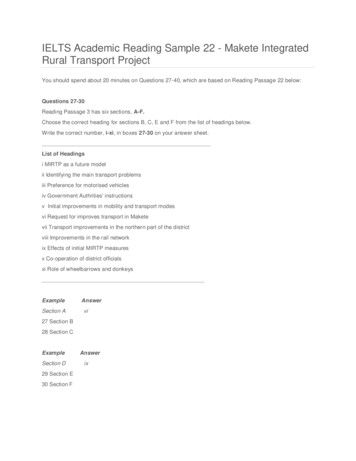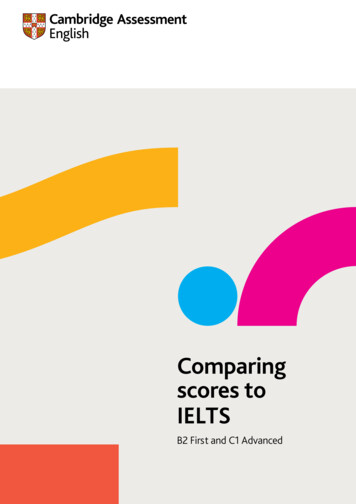
Transcription
IELTS Recent Mock TestsVolume 1Reading Practice Test 2HOW TO USEYou have 2 ways to access the test1. Open this URL http://link.intergreat.com/D3DVm on your computer2. Use your mobile device to scan the QR code attachedREADING PASSAGE 1You should spend about 20 minutes on Questions 1-13, which are based on Reading Passage1 below.Access https://ieltsonlinetests.com for more practicespage 1
How to Spot a LiarHowever much we may abhor it, deception comes naturally to all living things. Birds do it byfeigning injury to lead hungry predators away from nesting young. Spider crabs do it bydisguise: adorning themselves with strips of kelp and other debris, they pretend to besomething they are not – and so escape their enemies. Nature amply rewards successfuldeceivers by allowing them to survive long enough to mate and reproduce. So it may come asno surprise to learn that human beings- who, according to psychologist Gerald Johnson of theUniversity of South California, or lied to about 200 times a day, roughly one untruth every 5minutes- often deceive for exactly the same reasons: to save their own skins or to getsomething they can’t get by other means.But knowing how to catch deceit can be just as important a survival skill as knowing how to tella lie and get away with it. A person able to spot falsehood quickly is unlikely to be swindled byan unscrupulous business associate or hoodwinked by a devious spouse. Luckily, natureprovides more than enough clues to trap dissemblers in their own tangled webs- if you knowwhere to look. By closely observing facial expressions, body language and tone of voice,practically anyone can recognise the tell-tale signs of lying. Researchers are even programmingcomputers – like those used on Lie Detector -to get at the truth by analysing the same physicalcues available to the naked eye and ear. “With the proper training, many people can learn toreliably detect lies,” says Paul Ekman, professor of psychology at the University of California,San Francisco, who has spent the past 15 years studying the secret art of deception.In order to know what kind of Lies work best, successful liars need to accurately assess otherpeople’s emotional states. Ackman’s research shows that this same emotional intelligence isessential for good lie detectors, too. The emotional state to watch out for is stress, the conflictmost liars feel between the truth and what they actually say and do.Even high-tech lie detectors don’t detect lies as such; they merely detect the physical cues ofAccess https://ieltsonlinetests.com for more practicespage 2
emotions, which may or may not correspond to what the person being tested is saying.Polygraphs, for instance, measure respiration, heart rate and skin conductivity, which tend toincrease when people are nervous – as they usually are when lying. Nervous people typicallyperspire, and the salts contained in perspiration conducts electricity. That’s why sudden leap inskin conductivity indicates nervousness -about getting caught, perhaps -which makes, in turn,suggest that someone is being economical with the truth. On the other hand, it might alsomean that the lights in the television Studio are too hot- which is one reason polygraph testsare inadmissible in court. “Good lie detectors don’t rely on a single thing” says Ekma ,butinterpret clusters of verbal and non-verbal clues that suggest someone might be lying.”The clues are written all over the face. Because the musculature of the face is directlyconnected to the areas of the brain that processes emotion, the countenance can be a windowto the soul. Neurological studies even suggest that genuine emotions travel different pathwaysthrough the brain than insincere ones. If a patient paralyzed by stroke on one side of the face,for example, is asked to smile deliberately, only the mobile side of the mouth is raised. But tellthat same person a funny joke, and the patient breaks into a full and spontaneous smile. Veryfew people -most notably, actors and politicians- are able to consciously control all of theirfacial expressions. Lies can often be caught when the liars true feelings briefly leak through themask of deception. We don’t think before we feel, Ekman says. “Expressions tend to show upon the face before we’re even conscious of experiencing an emotion.”One of the most difficult facial expressions to fake- or conceal, if it’s genuinely felt - is sadness.When someone is truly sad, the forehead wrinkles with grief and the inner corners of theeyebrows are pulled up. Fewer than 15% of the people Ekman tested were able to produce thiseyebrow movement voluntarily. By contrast, the lowering of the eyebrows associated with anangry scowl can be replicated at will but almost everybody. “ If someone claims they are sadand the inner corners of their eyebrows don’t go up, Ekmam says, the sadness is probablyfalse.”The smile, on the other hand, is one of the easiest facial expressions to counterfeit. It takes justtwo muscles -the zygomaticus major muscles that extend from the cheekbones to the cornersof the lips- to produce a grin. But there’s a catch. A genuine smile affects not only the corners ofthe lips but also the orbicularis oculi, the muscle around the eye that produces the distinctive“crow’s feet” associated with people who laugh a lot. A counterfeit grin can be unmasked if thecorners of the lips go up, the eyes crinkle, but the inner corners of the eyebrows are notlowered, a movement controlled by the orbicularis oculi that is difficult to fake. The absence oflowered eyebrows is one reason why the smile looks so strained and stiff.Questions 1-5Access https://ieltsonlinetests.com for more practicespage 3
YESif the statement agrees with the views of the writerNOif the statement contradicts the views of the writerNOT GIVENif it is impossible to say what the writer thinks about this1All living animals can lie.2Some people tell lies for self-preservation.3Scientists have used computers to analyze which part of thebrain is responsible for telling lies.4Lying as a survival skill is more important than detecting a lie.5To be a good liar, one has to understand other people'semotions.Questions 6-9Choose the correct letter A, B, C or D.Write your answers in boxes 6-9.6 How does the lie detector work?AIt detects whether one's emotional state is stable.BIt detects one’s brain activity level.CIt detects body behavior during one's verbal response.DIt analyses one's verbal response word by word.7 Lie detectors can't be used as evidence in a court of law becauseALights often cause lie detectors to malfunction.BThey are based on too many verbal and non-verbal clues.CPolygraph tests are often inaccurate.DThere may be many causes of certain body behavior.8 Why does the author mention the paralyzed patients?ATo demonstrate how a paralyzed patient smilesBTo show the relation between true emotions and body behaviorAccess https://ieltsonlinetests.com for more practicespage 4
CTo examine how they were paralyzedDTo show the importance of happiness from recovery9 The author uses politicians to exemplify that they canAHave emotions.BImitate actors.CDetect other people's lives.DMask their true feelings.Questions 10-13Classify the following facial traits as referring toAsadnessBangerChappinessWrite the correct letter A,B or C in boxes 10-13.10111213Inner corners of eyebrows raisedThe whole eyebrows loweredLines formed aroundLines form above eyebrowsAccess https://ieltsonlinetests.com for more practicespage 5
READING PASSAGE 2You should spend about 20 minutes on Questions 14-26, which are based on Reading Passage2 below.Being Left-handed in a Right-handed WorldThe world is designed for right-handed people. Why does a tenth of the population prefer theleft?A The probability that two right-handed people would have a left-handed child is only about9.5 percent. The chance rises to 19.5 percent if one parent is a lefty and 26 percent if bothparents are left-handed. The preference, however, could also stem from an infant’s imitation ofhis parents. To test genetic influence, starting in the 1970s British biologist Marian Annett ofthe University of Leicester hypothesized that no single gene determines handedness. Rather,during fetal development, a certain molecular factor helps to strengthen the brain’s lefthemisphere, which increases the probability that the right hand will be dominant, because theleft side of the brain controls the right side of the body, and vice versa. Among the minority ofpeople who lack this factor, handedness develops entirely by chance. Research conducted ontwins complicates the theory, however. One in fivesets of identical twins involves one righthanded and one left-handed person, despite the fact that their genetic material is the same.Genes, therefore, are not solely responsible for handedness.B Genetic theory is also undermined by results from Peter Hepper and his team at Queen’sUniversity in Belfast, Ireland. In 2004 the psychologists used ultrasound to show that by the15th week of pregnancy, fetuses already have a preference as to which thumb they suck. Inmost cases, the preference continued after birth. At 15 weeks, though, the brain does not yetAccess https://ieltsonlinetests.com for more practicespage 6
have control over the body’s limbs. Hepper speculates that fetuses tend to prefer whicheverside of the body is developing quicker and that their movements, in turn, influence the brain’sdevelopment. Whether this early preference is temporary or holds up throughout developmentand infancy is unknown. Genetic predetermination is also contradicted by the widespreadobservation that children do not settle on either their right or left hand until they are two orthree years old.C But even if these correlations were true, they did not explain what actually causes lefthandedness. Furthermore, specialization on either side of the body is common among animals.Cats will favor one paw over another when fishing toys out from under the couch. Horsesstomp more frequently with one hoof than the other. Certain crabs motion predominantly withthe left or right claw. In evolutionary terms, focusing power and dexterity in one limb is moreefficient than having to train two, four or even eight limbs equally. Yet for most animals, thepreference for one side or the other is seemingly random. The overwhelming dominance of theright hand is associated only with humans. That fact directs attention toward the brain’s twohemispheres and perhaps toward language.D Interest in hemispheres dates back to at least 1836. That year, at a medical conference,French physician Marc Dax reported on an unusual commonality among his patients. During hismany years as a country doctor, Dax had encountered more than 40 men and women forwhom speech was difficult, the result of some kind of brain damage. What was unique wasthat every individual suffered damage to the left side of the brain. At the conference, Daxelaborated on his theory, stating that each half of the brain was responsible for certainfunctions and that the left hemisphere controlled speech. Other experts showed little interest inthe Frenchman’s ideas. Over time, however, scientists found more and more evidence ofpeopleexperiencing speech difficulties following injury to the left brain. Patients with damage tothe right hemisphere most often displayed disruptions in perception or concentration. Majoradvancements in understanding the brain’s asymmetry were made in the 1960s as a result ofso-called split-brain surgery, developed to help patients with epilepsy. During this operation,doctors severed the corpus callosum—the nerve bundle that connects the two hemispheres.The surgical cut also stopped almost all normal communication between the two hemispheres,which offered researchers the opportunity to investigate each side’s activity.E In 1949 neurosurgeon Juhn Wada devised the first test to provide access to the brain’sfunctional organization of language. By injecting an anesthetic into the right or left carotidartery, Wada temporarily paralyzed one side of a healthy brain, enabling him to more closelystudy the other side’s capabilities. Based on this approach, Brenda Milner and the lateTheodore Rasmussen of the Montreal Neurological Institute published a major study in 1975that confirmed the theory that country doctor Dax had formulated nearly 140 years earlier: inAccess https://ieltsonlinetests.com for more practicespage 7
96 percent of right-handed people, language is processed much more intensely in the lefthemisphere. The correlation is not as clear in lefties, however. For two thirds of them, the lefthemisphere is still the most active language processor. But for the remaining third, either theright side is dominant or both sides work equally, controlling different language functions. Thatlast statistic has slowed acceptance of the notion that the predominance of right-handedness isdriven by left-hemisphere dominance in language processing. It is not at all clear why languagecontrol should somehow have dragged the control of body movement with it. Some expertsthink one reason the left hemisphere reigns over language is because the organs of speechprocessing—the larynx and tongue—are positioned on the body’s symmetry axis. Becausethese structures were centered, it may have been unclear, in evolutionary terms, which side ofthe brain should control them, and it seems unlikely that shared operation would result insmooth motor activity. Language and handedness could have developed preferentially for verydifferent reasons as well. For example, some researchers, including evolutionary psychologistMichael C. Corballis of the University of Auckland in New Zealand, think that the origin ofhuman speech lies in gestures. Gestures predated words and helped language emerge. If theleft hemisphere began to dominate speech, it would have dominated gestures, too, and becausethe left brain controls the right side of the body, the right hand developed more strongly.F Perhaps we will know more soon. In the meantime, we can revel in what, if any, differenceshandedness brings to our human talents. Popular wisdom says right-handed, left-brainedpeople excel at logical, analytical thinking. Lefthanded, right-brained individuals are thought topossess more creative skills and may be better at combining the functional features emergentin both sides of the brain. Yet some neuroscientists see such claims as pure speculation. Fewerscientists are ready to claim that left-handedness means greater creative potential. Yet leftiesare prevalent among artists, composers and the generally acknowledged great politicalthinkers. Possibly if these individuals are among the lefties whose language abilities are evenlydistributed between hemispheres, the intense interplay required could lead to unusual mentalcapabilities.G Or perhaps some lefties become highly creative simply because they must be more clever toget by in our right-handed world. This battle, which begins during the very early stages ofchildhood, may lay the groundwork for exceptional achievements.Questions 14-18Reading Passage 2 has seven sections A-G.Which section contains the following information?Write the correct letter A-G in boxes 14-18 on your answer sheet.Access https://ieltsonlinetests.com for more practicespage 8
1415161718Preference of using one side of the body in animal species.How likely one-handedness is born.The age when the preference of using one hand is settled.Occupations usually found in left-handed population.A reference to an early discovery of each hemisphere’s function.Questions 19-22Look at the following researchers (Questions 19-22) and the list of findings below.Match each researcher with the correct finding.Write the correct letter A-G in boxes 19-22 on your answer sheet.List of FindingsAEarly language evolution is correlated to body movement and thus affecting thepreference of use of one hand.BNo single biological component determines the handedness of a child.CEach hemisphere of the brain is in charge of different body functions.DLanguage process is mainly centered in the left-hemisphere of the brain.ESpeech difficulties are often caused by brain damage.FThe rate of development of one side of the body has influence on hemispherepreference in fetus.GBrain function already matures by the end of the fetal stage.19202122Marian AnnettPeter HepperBrenda Milner & Theodore RasmussenMichael CorballisQuestions 23-26Do the following statements agree with the information given in Reading Passage2?In boxes 23-26 on your answer sheet writeAccess https://ieltsonlinetests.com for more practicespage 9
YESif the statement agrees with the views of the writerNOif the statement contradicts the views of the writerNOT GIVENif it is impossible to say what the writer thinks about this23The study of twins shows that genetic determinationis not theonly factor for left-handedness.2425Marc Dax’s report was widely accepted in his time.Juhn Wada based his findings on his research of people withlanguage problems.26There tend to be more men with left-handedness than women.Access https://ieltsonlinetests.com for more practicespage 10
READING PASSAGE 3You should spend about 20 minutes on Questions 27-40, which are based on Reading Passage3 below.What is a dinosaur?A. Although the name dinosaur is derived from the Greek for "terrible lizard", dinosaurs werenot, in fact, lizards at all. Like lizards, dinosaurs are included in the class Reptilia, or reptiles, oneof the ve main classes of Vertebrata, animals with backbones. However, at the next level ofclassi cation, within reptiles, signi cant differences in the skeletal anatomy of lizards anddinosaurs have led scientists to place these groups of animals into two different superorders:Lepidosauria, or lepidosaurs, and Archosauria, or archosaurs.B . Classi ed as lepidosaurs are lizards and snakes and their prehistoric ancestors. Includedamong the archosaurs, or "ruling reptiles", are prehistoric and modern crocodiles, and the nowextinct thecodonts, pterosaurs and dinosaurs. Palaeontologists believe that both dinosaurs andcrocodiles evolved, in the later years of the Triassic Period (c. 248-208 million years ago), fromcreatures called pseudosuchian thecodonts. Lizards, snakes and different types of thecodontare believed to have evolved earlier in the Triassic Period from reptiles known as eosuchians.C. The most important skeletal differences between dinosaurs and other archosaurs are in thebones of the skull, pelvis and limbs. Dinosaur skulls are found in a great range of shapes andsizes, re ecting the different eating habits and lifestyles of a large and varied group of animalsthat dominated life on Earth for an extraordinary 165 million years. However, unlike the skullsof any other known animals, the skulls of dinosaurs had two long bones known as vomers.These bones extended on either side of the head, from the front of the snout to the level of theholes on the skull known as the antorbital fenestra, situated in front of the dinosaur's orbits oreyesockets.D. All dinosaurs, whether large or small, quadrupedal or bipedal, eet-footed or slow-moving,shared a common body plan. Identi cation of this plan makes it possible to differentiateAccess https://ieltsonlinetests.com for more practicespage 11
dinosaurs from any other types of animal, even other archosaurs. Most signi cantly, indinosaurs, the pelvis and femur had evolved so that the hind limbs were held vertically beneaththe body, rather than sprawling out to the sides like the limbs of a lizard. The femur of adinosaur had a sharply in-turned neck and a ball-shaped head, which slotted into a fully openacetabulum or hip socket. A supra-acetabular crest helped prevent dislocation of the femur.The position of the knee joint, aligned below the acetabulum, made it possible for the wholehind limb to swing backwards and forwards. This unique combination of features gavedinosaurs what is known as a "fully improved gait". Evolution of this highly ef cient method ofwalking also developed in mammals, but among reptiles it occurred only in dinosaurs.E. For the purpose of further classi cation, dinosaurs are divided into two orders: Saurischia, orsaurischian dinosaurs, and Ornithischia, or ornithischian dinosaurs. This division is made on thebasis of their pelvic anatomy. All dinosaurs had a pelvic girdle with each side comprised ofthree bones: the pubis, ilium and ischium. However, the orientation of these bones follows oneof two patterns. In saurischian dinosaurs, also known as lizard-hipped dinosaurs, the pubispoints forwards, as is usual in most types of reptile. By contrast, in ornithischian, or birdhipped, dinosaurs, the pubis points backwards towards the rear of the animal, which is alsotrue of birds.F . Of the two orders of dinosaurs, the Saurischia was the larger and the rst to evolve. It isdivided into two suborders: Therapoda, or therapods, and Sauropodomorpha, orsauropodomorphs. The therapods, or "beast feet", were bipedal, predatory carnivores. Theyranged in size from the mighty Tyrannosaurus rex, 12m long, 5.6m tall and weighing anestimated 6.4 tonnes, to the smallest known dinosaur, Compsognathus, a mere 1.4m long andestimated 3kg in weight when fully grown. The sauropodomorphs, or "lizard feet forms",included both bipedal and quadrupedal dinosaurs. Some sauropodomorphs were carnivorousor omnivorous but later species were typically herbivorous. They included some of the largestand best-known of all dinosaurs, such as Diplodocus, a huge quadruped with an elephant-likebody, a long, thin tail and neck that gave it a total length of 27m, and a tiny head.G. Ornithischian dinosaurs were bipedal or quadrupedal herbivores. They are now usuallydivided into three suborders: Ornithipoda, Thyreophora and Marginocephalia. The ornithopods,or "bird feet", both large and small, could walk or run on their long hind legs, balancing theirbody by holding their tails stif y off the ground behind them. An example is Iguanodon, up to9m long, 5m tall and weighing 4.5 tonnes. The thyreophorans, or "shield bearers", also knownas armoured dinosaurs, were quadrupeds with rows of protective bony spikes, studs, or platesalong their backs and tails. They included Stegosaurus, 9m long and weighing 2 tonnes.H . The marginocephalians, or "margined heads", were bipedal or quadrupedal ornithschianswith a deep bony frill or narrow shelf at the back of the skull. An example is Triceratops, arhinoceros-like dinosaur, 9m long, weighing 5.4 tonnes and bearing a prominent neck frill andthree large horns.Access https://ieltsonlinetests.com for more practicespage 12
Questions 27-33Reading Passage 3 has 8 paragraphs (A-H).Choose the most suitable heading for each paragraph from the List of headingsbelow.Write the appropriate numbers (i-xiii) in Boxes 27-33 on your answer sheet.One of the headings has been done for you as an example.NB. There are more headings than paragraphs, so you will not use all of them.27282930313233Paragraph AParagraph BParagraph CParagraph DParagraph EParagraph FParagraph GExample : Paragraph HAnswer: xAccess https://ieltsonlinetests.com for more practicespage 13
List of headingsi165 million yearsiiThe body plan of archosaursiiiDinosaurs - terrible lizardsivClassification according to pelvic anatomyvThe suborders of SaurischiaviLizards and dinosaurs - two distinct superordersviiUnique body plan helps identify dinosaurs from other animalsviiiHerbivore dinosaursixLepidosaursxFrills and shelvesxiThe origins of dinosaurs and lizardsxiiBird-hipped dinosaursxiiiSkull bones distinguish dinosaurs from other archosaursQuestions 34-36Complete then sentences below.Use NO MORE THAN THREE WORDS from the passage for each blank space.Write your answers in boxes 34-36 on your answer sheet.Lizards and dinosaurs are classified into two different superorders because of thedifference in their 34In the Triassic Period, 35snakes.evolved into thecodonts, for example, lizards andDinosaur skulls differed from those of any other known animals because of thepresence of vomers: 36Questions 37-40Choose one phrase (A-H) from the List of features to match with the Dinosaurslisted below.Write the appropriate letters (A-H) in boxes 37-40 on your answer sheet.The information in the completed sentences should be an accurate summary of theAccess https://ieltsonlinetests.com for more practicespage 14
points made by the writer.NB. There are more phrases (A-H) than sentences, so you will not need to use themall.You may use each phrase once only.Dinosaurs37383940Dinosaurs differed from lizards, becauseSaurischian and ornithischian dinosaursUnlike therapods, sauropodomorphsSome dinosaurs used their tails to balance and could walkList of featuresAare both divided into two orders.Bthe former had a "fully improved gait".Cwere not usually very heavy.Dcould walk or run on their back legs.Etheir hind limbs sprawled out to the side.Fwalked or ran on four legs, rather than two.Gboth had a pelvic girdle comprising six bones.Hdid not always eat meat.Access https://ieltsonlinetests.com for more practicespage 15
Solution:14C15A16B17F18D19B20F21D22A23YES24NO25NOT GIVEN26NOT GIVEN1YES2YES3NOT GIVEN4NO5YES27vi28xiAccess https://ieltsonlinetests.com for more practicespage 16
29xiii30vii31iv32v33viii6C7D8B9D34skeletal anatomy35eosuchians36two long bones10A11B12C13A37B38G39H40DAccess https://ieltsonlinetests.com for more practicespage 17
Being Left-handed in a Right-handed World The world is designed for right-handed people. Why does a tenth of the population prefer the left? A The probability that two right-handed people would have a left-handed child is only about 9.5 percent. The chance rises to 19.5 percent if one parent is a lefty and 26 percent if both parents are left .











